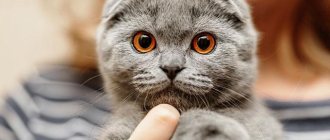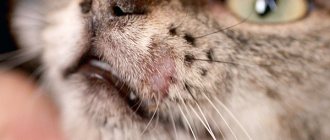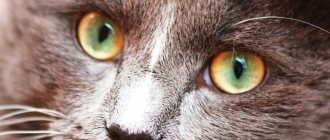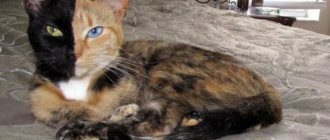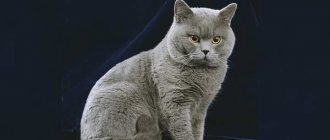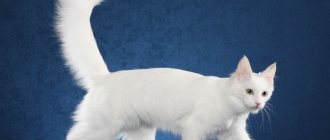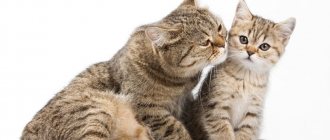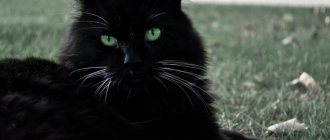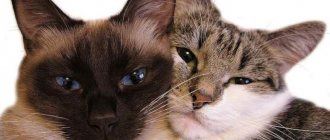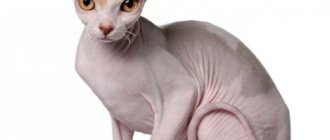The color of a cat as a guarantee of its uniqueness
No one will argue that cats are very different. And we are talking here not only and not so much about the breed, since even within the same breed, animals can differ significantly in appearance. It's about color.
Photo gallery: Persian cats of different colors
The red Persian cat always has stripes on his fur.
The stripes on the coat of a cream-colored Persian cat are almost indistinguishable
The Persian cat has a blue coat with an even, uniform tone.
The Persian cat of the Himalayan red color has a very light body, and the paws, tail, muzzle and ears are darker
The colors of cats are endlessly varied: from the deceptively simple to the most amazing and imaginative. And what kind of fur coat a kitten will have depends on its heredity, on the blood of its parents.
Amazing pigment
In fact, the color of any cat is determined by three main factors:
- coat color;
- intensity of fur color (for example, a cat can be black, or maybe dark gray);
- the presence or absence of a pattern on the wool.
At the same time, there are not and never have been two cats of exactly the same color in the world. And all this riot of colors and shades is provided with the help of a single coloring substance contained in animal fur - the melanin pigment. More precisely, two varieties of this pigment: eumelanin, responsible for black coloring, and pheomelanin, responsible for red (orange, yellow) coloring. So cats have only two basic colors: red and black.
At the same time, the mechanism of cat heredity works in such a way that for female cats there are three possible color options (red color, black color and their “mixture” - tortoiseshell red-black color), and male cats can be either black or red.
A tortoiseshell-colored cat has a fur coat full of black and red (orange, red, yellow) spots.
In fact, in nature sometimes there are cats of “tortoiseshell” color, but these are single specimens, the fruits of a gene mutation. And, unfortunately, such cats do not produce offspring.
What is polar bear fur made of?
The polar bear's fur contains two layers of hairs: an outer protective layer consisting of long (5-15 cm) guard hairs; and a dense insulating undercoat, the hairs of which are shorter and finer than those in the protective layer.
The polar bear's skin is black and its fur is translucent.
Properties of protective hairs:
- translucent;
- hollow, i.e. empty inside;
- rough, narrowed (gradually reaching the base);
- contain particles that scatter light;
- contain salt particles;
- consist of the protein “keratin”.
The translucent hairs of the bear's fur also appear white due to the thickness of the animal's fur.
“Solid” and “patterned” cats
Red, black, even “tortoiseshell” coloring is definitely not enough to explain the endless variety of colors of cats. This is because cats can be uniformly colored or have a pattern (for example, circles or stripes).
Uniform (solid) cat colors are called solid, and colors with patterns are called tabby (or tabby).
With a solid color, the animal's fur has the same tone over the entire surface of the body, and the hairs are colored equally and evenly along the entire length.
Photo gallery: uniform (solid) cat colors
Black Bombay is a cat with perfectly black fur, without the slightest hint of spots or individual undyed hairs.
The chocolate exotic has a dark brown uniform coat tone.
In the lilac color of the British dog, blue and pink are intertwined
The pattern, called tabby, occurs due to the fact that in the darker areas of the animal's fur there is a greater amount of eumelanin (the pigment responsible for the black color) than in the lighter areas.
It is believed that it is tabby that is inherent in cats initially, that this is their natural “wild” color. Animals with this color are characterized by thinly outlined eyes and the presence of the letter “M” (or “scarab”) on the forehead. In addition, their cheekbones are emphasized by smooth descending lines.
A wild-colored Egyptian Mau cat has thin lines around the eyes and emphasized cheekbones, and on the forehead there is a characteristic “scarab” pattern (the letter “M”)
By the way, red (ginger) and cream cats are always “patterned”, it’s just that sometimes their pattern is barely distinguishable.
There are several main varieties of cat tabby pattern:
- tabby mackerel - striped “tiger” color, pattern in the form of parallel vertical stripes;
- classic tabby, marbled tabby - a color with wide spiral stripes on the sides, reminiscent of marble stains, with three stripes along the ridge, a spotted belly, stripes in the form of rings on the tail and paws;
- spotted tabby - a color with evenly spaced small spots throughout the body; spots may appear in the form of intermittent stripes.
Photo gallery: main types of tabby pattern
Striped tabby or mackerel tabby - a pattern of parallel vertical stripes on the cat's body Marbled or classic tabby - a pattern with wide spiral stripes on the sides of the cat Spotted tabby - a pattern with small spots or intermittent stripes throughout the cat's body
But if initially all cats have a pattern (tabby), where do animals with a solid color come from?
Why does a cat need ticking?
The fact is that a tabby on a cat's fur coat appears only when each hair on the animal is divided into zones with different color intensities, that is, painted with stripes. This is the so-called agouti effect (or ticking), which is also determined by the mechanism of heredity.
With zoned coloring of cat hair (agouti effect), one or more darker stripes are located on a light background
It is the differently colored hairs that form the pattern on the animal’s fur coat. If there is no agouti effect, and each hair in the fur has an even tone along its entire length, then the cat’s color will be solid.
There is a separate type of tabby cat pattern, when on a light background of each hair there are two or three horizontal dark stripes, and all hairs are colored the same. This pattern is called ticked (Abyssinian) tabby. In this case, the animal has no stripes or spots on the body, although the characteristic pattern on the muzzle and partially on the paws and tail are preserved; the fur seems to be strewn with small, small freckles and looks shimmering. This color is typical for Abyssinian cats.
The wild-colored Abyssinian cat has no spots or stripes on the body, but retains the characteristic tabby pattern on the face (eyes outlined in thin lines and a scarab mark on the forehead)
Ticking of cat fur has several options and manifests itself in the color of the animal with different effects: from light “shadedness” (when the very tip of the hair is colored) to deep “smokiness” (when the hair is colored almost the entire length).
Photo gallery: options for displaying the agouti effect (zoned dyeing) on a hair of cat hair
Hair with ticked shaded color Hair with shaded color Hair with shaded red (cameo) color Hair with smoky color
If we talk about shaded colors, they are very much appreciated by lovers of the British and Persian breeds. The idea here is that each hair is dyed only by a third (approximately), and the remaining part is significantly lighter than the dyed area. As a result, it seems that a translucent veil is draped over the animal.
British woman with shaded color, as if covered with a translucent veil
Thus, the base color (black or red) + tabby + presence/absence of ticking and its variety = the whole variety of cat colors (with some exceptions, which we will talk about later).
Types of elite wool
The following main types of elite wool are distinguished:
Cashmere (WS)
CASHMERE is the finest down (undercoat) of the high-mountain cashmere goat, which lives in the Tibet region and in the Kashmir province between India and Pakistan. Cashmere goats are also bred in Australia, New Zealand and Scotland.
Cashmere is an exquisite, chic, trendy, sophisticated and rightfully the most expensive material. It is no coincidence that it is called “royal yarn”, “wool diamond” or “precious thread”.
Cashmere raw material consists of threads that are only 13-19 microns thick (human hair is 50 microns), so touching cashmere creates a feeling of splendor. Cashmere is so delicate that any shade in which it is dyed looks as if through a slight haze, very pleasant to the eye.
To obtain fluff, the goat is not shorn, but is combed by hand once a year, in the spring, during molting. At the same time, one goat brings only 100 - 200 grams of fluff, and 1.5 - 1.8 kg of cashmere linen is spent on the production of a coat, that is, the fluff of 15 animals. This is one of the reasons for the very high price of 100% cashmere products. Another reason for the popularity and high cost of cashmere is its exceptional softness, lightness, ability to retain heat and the absence of allergic reactions to it.
The popularity of cashmere is constantly growing. Today, buyers choose cashmere as the best available on the market. It may be expensive, but the exceptional comfort it creates is attracting more and more fans of this material around the world.
Alpaca (WP)
ALPACA is a type of llama. It lives in the Peruvian Andes at an altitude of 4000-5000m. in extreme conditions (bright sun, cold wind, sudden temperature changes).
The alpaca is a rare animal; its wool is expensive; alpacas are shorn, unlike sheep. once a year and receive only 3-3.5 kg of wool from one animal.
Alpaca wool has exceptional properties:
- it is light, soft, homogeneous and silky, maintaining a unique silky shine for the entire service life of the product; very warm (7 times warmer than sheep), with high thermoregulatory properties (it is warm in the cold and not hot in the warm);
- durable (3 times stronger than sheepskin), not subject to rolling, falling or jamming;
- resistant to contamination and does not cause allergic reactions;
- unlike the scaly and therefore prickly fibers of sheep wool, alpaca fibers are smooth and comfortable to the touch;
- it has the largest range of natural colors (22 shades: from black, gray, burgundy, brown, cream to white).
No other type of wool has such qualities. All of these properties create a feeling of unique aesthetic and physical comfort for owners of alpaca wool products.
SURY ALPACA. There are two known breeds of alpaca: HUAKAYA and SURI.
Huacaya is the most numerous and resembles a fluffy bear cub in appearance. In most cases, this is the gender that is meant by the name “alpaca”.
Suri is the rarest (about 120 thousand alpacas in total - 5%) and valuable (2 times more expensive than Huacaya).
Compared to Huacaya, Suri fleece consists of longer and thinner fibers (19-25 microns) - these are uniform and thick curls, straight along the entire length and slightly curled at the ends, they do not contain guard hairs that reduce the quality of the fleece.
Suri wool is particularly soft and elegant. In the old days, it was used exclusively for royalty.
BABY SURY ALPACA. Depending on the thickness of the fibers, alpaca fleece is sorted into five quality categories.
The highest quality wool is the “BABY” type (20 microns). If the original fleece was Suri, then it represents the finest, rarest and most expensive alpaca wool, called "Baby Suri alpaca" - this is the highest quality alpaca in the world.
Angora (WA) ANGORA (ANGORA) - This is the fluff of Angora rabbits.
Once upon a time, China, in response to Turkey’s inflated prices for the sought-after wool of Angora goats, produced a softer and cheaper yarn called “Angora”. As it turned out, it was the fluff of wild rabbits called Angora. Under these conditions, the Turks called the wool of Angora goats “mohair,” which means “chosen” in Arabic. Subsequently, Angora rabbits began to be bred in Europe and the USA.
Angora rabbits are the most adorable of rabbits, reminiscent of a soft toy come to life. Currently, five breeds of Angora rabbits are commercially bred in the world: English, French, German, Giant and Satin. They differ in size and weight (2.5-5.5 kg), length of down fibers, thickness of guard hair, color, volume of wool produced annually (0.4-1.3 kg).
Angora wool is exceptionally soft, very warm and fluffy, with a characteristic delicate pile. Products made from Angora wool create unique comfort and are therefore very popular and in demand. However, Angora wool also has its drawbacks: weak fixation of rabbit fluff in the yarn can cause abrasion of the fabric; the need to protect the angora from excessive wetting and clean it only chemically. However, products made from high-quality angora can last for more than one year.
Merino wool MERINO WOOL (MERINOS) is wool taken from the withers of a Merino sheep. Merinos, a breed of fine-wool sheep, whose homeland is considered to be Western Asia. Subsequently, they spread to Western Europe, North America and Australia.
Today in Australia alone there are about 150 million merino sheep, with one sheep on average producing up to 15 kg of wool per year (other breeds of sheep 6-7 kg). The yield of pure wool is 35-45%.
Merino wool is uniform and consists of very fine (13.5-23 microns) and soft downy fibers (23-35 microns in coarse breeds). It is long (annual coat length 6-8 cm), white, warm, and has excellent thermostatic properties. Due to natural curls, it is elastic. It is important that it does not irritate the skin.
Merino wool is more expensive than regular wool. The price of the best lots of this wool (14-16 microns) at annual auctions reached several thousand dollars per kilogram.
Camel hair CAMEL WOOL (CAMEL) is the downy undercoat of the non-working Bactrian camel (Bactrian), living in Central and East Asia. The most valuable wool is the Mongolian Bactrian.
The camel's coat consists of outer coarse hair (25-100 microns) and inner soft fluff (17-21 microns), accounting for 80-85% of the volume. This is what is called “camel hair”. Once a year, 4-9 kg of it is collected (or combed) from one camel, sorted by color and composition, after which the finest and softest fluff is sent for fabric production. To make high-quality fabrics, the lightest and finest down of young camels (up to a year) is usually used.
How to embrace the immensity: the main varieties of cat colors
Diversity is diversity, but no one has canceled systematization. Therefore, all possible colors of cats were divided into several groups.
Table: main groups of cat colors
| Color group | General characteristics of the color group | Colors included in the group | Description of color |
| Solid colors | All hairs are well dyed to the roots, without patterns or any stains |
|
|
| Silver colors | A certain area of each hair is bleached white |
|
|
| Acromelanistic colors (colorpoint) | Body slightly colored, light (from white to cream); paws, tail, muzzle and ears are darker. |
|
|
All tabby, shaded and chinchilla colors are grouped together as agouti colors because it is the agouti effect that allows them to show up on a cat's coat.
Story
| Classic | ||
| 0.0.20 | Wool color palette in Classic. | |
| 0.27 SURVIVAL TEST 11 | Added a sheep that drops red cloth when killed. | |
| 0.27 SURVIVAL TEST 12 | Sheep now drop white wool instead of red. | |
| Indev | ||
| February 23, 2010 | Added a painting that uses fabric in crafting. | |
| Alpha | ||
| 1.0.1 | The sheep can now regenerate its wool. | |
| 1.0.8 | Changed the crafting of leather/fabric armor from fabric to leather. | |
| 1.1.0 | Sheep now drops 1-3 fabrics instead of 2. | |
| Beta | ||
| 1.2 | Wool color palette in Beta. | |
| The color palette of the fabric has been changed. | ||
| The fabric has been renamed wool. | ||
| Added 15 dyes; A white sheep can be dyed by right-clicking with any dye in hand. | ||
| Light grey, gray and black sheep can spawn naturally and drop the corresponding colored wool. | ||
| 1.4 | Brown and pink sheep can spawn naturally and drop the corresponding colored wool. | |
| 1.6.6 | The wool crafting recipe has been changed; it now requires 4 threads instead of 9. | |
| 1.7 | Added scissors to shear a sheep, dropping 2-4 blocks of wool. | |
| A sheep does not drop wool when hit, but an unshorn sheep only drops one wool when killed. | ||
| 1.8 | NPC villages are generated with lamps, the main part of the lamp is black wool. | |
| Release | ||
| 1.1 | Sheep can again eat grass and tall grass to regenerate their wool; a painted sheep leaves color. | |
| 1.2.4 | Changed the saturation of the palette. . | |
| 1.3.2 | 12w21a | 54 orange and one blue wool are generated in desert temples. |
| 1.6 | 13w16a | Added carpet, which can be crafted from two blocks of wool of the corresponding color. |
| 1.8 | 14w02a | Residents now trade wool. |
| 14w03a | Desert temples no longer generate wool. | |
| Alpha version of the pocket edition | ||
| 0.1.0 | Added wool (all 16 colors, but not all can be obtained). | |
| 0.2.0 | Added the ability to shear sheep. | |
| 0.4.0 | Added wool crafting. | |
| 0.8.0 | Wool can be used in carpet crafting. | |
| 0.9.0 | build 1 | NPC villages are generated with lamps, the main part of the lamp is black wool. |
| 0.9.3 | Wool now uses smoothed lighting. | |
| Console editions | ||
| TU1 | Added wool (all 16 colors). | |
| TU9 | The sheep regenerates its wool by eating grass. | |
| Pi edition | ||
| 0.1.1 | Added wool (all 16 colors). | |
When breed and color are inseparable
The same type of color can be found in cats of different breeds: there are “marbled” Siberian cats and “marbled” British cats, spotted Oriental cats and spotted Bengals, “colorpoint” Persians and “colorpoint” Burmese cats. But there are breeds for which, according to the standard, only one type of color is possible.
Table: some cat breeds with the only type of color allowed for them by the standard
| Color | Mandatory and exclusive for the breed | Allowed for the breed |
| Black solid | Bombay cat |
|
| Striped Tabby | Toyger |
|
| Spotted Tabby |
|
|
| Ticked Tabby |
|
|
Of course, the same type of color looks completely different, for example, on long-haired and short-haired animals.
Photo gallery: cats of different breeds of spotted tabby color
In a short-haired spotted cat of the Egyptian Mau breed, the spots are clearly defined, and on the tail and paws they can turn into stripes. In a silver spotted Siberian cat, the lighter areas of the body are lightened to white. Although the spotted Pallas cat has a characteristic letter “M” (the “scarab” sign) on the forehead spots, his eyes are circled, and his cheekbones are emphasized by the obligatory thin lines
But anyway, cats are amazingly beautiful, right?
Whiter than snow
It's time to talk about exceptions left for later.
Among all the colored cat diversity, white cats stand apart. Essentially, such cats are colorless because they lack any pigmentation. But not everything is so simple, because the white color of an animal can be due to several reasons:
- the presence of a white color gene;
- the presence of the albinism gene;
- presence of the white spotting gene.
In the first case, the white color gene simply suppresses the “color” genes that the individual has. In the offspring of such a cat, “colored” genes are highly likely to appear again. In addition, the white color gene affects the eye color (they are usually blue in such cats) and can be paired with the deafness gene. Therefore, about 5% of white cats with blue eyes are deaf.
In addition to blue-eyed white cats, there are white cats with copper, dark orange and green eyes (Turkish Angora) and white cats with multi-colored eyes (Kao Mani).
Albino cats are very rarely born in nature. Their eyes are light blue or red, and such cats do not suffer from deafness. But they often have pathologies of internal organs, and their eyes are extremely sensitive to sunlight.
The white spotting gene is responsible for the “piebald” color of the animal. In piebald cats, white (colorless) spots are located on a colored (colored) background. Depending on the degree of filling of the colored background with such white spots, the following types of color are distinguished:
- Van - (maximum degree of filling) all white with a colored tail and 1-2 small colored spots on the head above eye level and below the ears. There may also be a small colored patch in the shoulder area and small spots on the backs of the limbs.
- The Harlequin is primarily white with a few small colored spots located on the body and limbs.
- Bicolor - most of the skin is dark, and the smaller part is uncolored, white, in an indefinite ratio.
- Calico is a combination of tortoiseshell and white, with white being the predominant color. In everyday life, such cats are also called tricolor or tricolor.
Photo gallery: white cats
A white cat with the white color gene usually has bright blue eyes. A white albino cat has red eyes. A cat with the Van color has a colored tail and spots on the head above the level of the eyes and below the ears. A cat with the Harlequin color has colored spots located on the body. and limbs In tri-colored cats, tortoiseshell color is combined with white
Since ancient times, people have admired snow-white beauties, and in Turkey, for example, it is still generally accepted that a white cat with blue eyes provides its owner with absolution. But when you are planning to bring a white kitten into your home, remember that such an animal needs especially careful care. If only because his fur coat is much more soiled than others, and dirty eyes or ears against a white background look extremely unattractive. And you shouldn’t discount possible hearing problems: such a pet should not walk on the street alone, this can be deadly for him.
Whitening white wool with affordable folk remedies
Many people love knitted wool products, but they often refuse to buy them, fearing that the item will quickly lose its dazzling whiteness and become unusable. A white sweater or fluffy woolen scarf that has turned yellow from time and constant wear can be saved, and there is no need to resort to expensive store-bought products.
Substances with bleaching properties are easy to find in your home medicine cabinet or kitchen cabinet. The main advantage of folk recipes for bleaching woolen items at home is their availability and ease of use, and due to their low cost, it is more profitable to use them than ready-made compounds from the store.
On a note! When using folk remedies, you should start with a minimum concentration of the solution. If it was not possible to effectively bleach woolen items the first time, then you can increase the dosage of the active component.
Sodium hyposulfite
The powder, consisting of small white crystals, can be purchased at a pharmacy kiosk. This pharmacological agent has moderate bleaching properties and is suitable for restoring color to light-colored items, including those made from natural sheep’s wool. Bleaching is carried out before the main wash cycle. To soak yellowed woolen items, prepare a basin with warm water, pour one packet of sodium hyposulfite into it, immerse the item of clothing in the solution and leave for 1–2 hours. You can enhance the bleaching effect if you cover the container with the composition with plastic wrap or a lid. After soaking in the solution, wash woolen items as usual, not forgetting to add vinegar or a special balm to the rinse water.
Hydrogen peroxide
One of the most famous and effective home bleaches is the pharmaceutical antiseptic hydroperite. Hydrogen peroxide not only helps to whiten woolen items, but also strengthens the structure of the fibers, so that the products do not lose strength, hold their shape better and do not pill.
To restore the bright color of white sweaters, hats and other wool clothing, you should prepare a solution of one part hydroperite and eight parts warm water. To bleach things with obvious signs of yellowness, you can heat the liquid to 50–60 degrees. The products are immersed in the solution, allowed to sit for 30 to 60 minutes, and then rinsed thoroughly.
On a note! To ensure uniform bleaching, it is recommended that during soaking, periodically change the position of things in the solution, turning them over, and also ensure that the immersion is complete.
Salt
Saline solution is used in many folk recipes for safe bleaching and color restoration of light-colored products, including those made from delicate materials. Woolen clothes can be revived without fear with the help of table salt. This method is suitable not only for eliminating yellowness and gray tints, but also for preventing discoloration.
To bleach a wool jacket, hat or dress, you need to prepare a medium-strength solution of five liters of warm water and a glass of table salt. Items are soaked for several hours before the main wash cycle, and then washed as usual using washing powder for delicate fabrics and fabric softener.
A similar result is obtained if you use baking soda instead of salt. In addition to its gentle bleaching effect, soda solution has the property of softening water with increased hardness.
Chalk
You can bleach the fibers of a woolen product using chalk. This method is considered one of the most labor-intensive, but absolutely safe for all types of wool. Since you need to prepare a bleaching agent with the addition of a large amount of chalk, it is more convenient to use it to restore the whiteness of small things - hats, scarves, mittens.
Before bleaching, you need to weigh your clothes using a kitchen scale and then do some small calculations. You will need one kilogram of chalk per three liters of water and five hundred grams of wool. The solution in which things are soaked to bleach them must be warm, and the soaking time depends on the degree of color change. After receiving a positive result, woolen products are rinsed in acidified water.
Laundry soap
Woolen clothing with a cotton blend can be boiled to restore its whiteness. Before using this method, you need to carefully study the label and acceptable temperature treatment conditions so as not to spoil the item. Boiling is always accompanied by the release of a large amount of steam, so it is better to use this method if you need to process several hats and scarves at the same time or a couple of large sweaters.
It is better to boil woolen products in a solution of water and laundry soap, which should first be grated. The items intended for bleaching are dipped into the liquid, brought to a boil and left to simmer for 15–20 minutes, after which they are allowed to cool. After bleaching by boiling with laundry soap, you need to rinse clothes in a slightly acidic solution, dissolving 1-2 tablespoons of table vinegar in 10 liters of water.
Ammonia
A few bottles of ammonia will help get rid of yellowness and return the bright color to white woolen items. The only condition is that after bleaching, it is necessary to rinse the clothes in water with the addition of acetic acid or fabric softener, since after using ammonia, an unpleasant odor may appear. It is better to work with gloves, and while preparing the solution, protect your face with a medical mask.
How to bleach woolen items with ammonia:
- Ten liters of warm water will require 100 ml of 10% ammonia. The items are immersed in the solution, left for half an hour, and then washed in a washing machine or by hand using detergent for delicate fabrics.
- For significantly yellowed wool, as well as in the presence of stains, a more concentrated product should be used. For ten liters of water, you will need to take a double portion of ammonia, immerse the clothes in a basin, and cover the top with plastic wrap. After half an hour, you can wash woolen items as usual.
A good effect is achieved by using a solution of ammonia with the addition of hydrogen peroxide. Both products are taken in equal proportions based on the calculation of 50 ml of each per 10 liters of water.
Red devils and timid white angels
No matter how strange it may sound, there is an opinion that the character of a cat is in some mysterious way connected with its color. Moreover, even some breeders and veterinarians think so, that is, people who, by definition, deal with a large number of these same cats.
Table: the estimated character of a cat depending on its color
| Cat color | Character |
| Black and white, gray, black tabby | Stress-resistant, the best possible |
| Calico | Demanding, independent, dedicated |
| White (with blue eyes) | Timid |
| Colorpoint with brown marks | Quite aggressive |
| Ginger | Brash, capricious, vindictive |
| Silver and brown spotted tabby | Nightmarish beyond description |
| Classic brown tabby or mackerel | Affectionate, flexible, playful |
| Blue (tabby or solid) | Friendly, contactable |
Ordinary cat lovers also notice some patterns.
From my experience (and from various sources): red cats are very independent, independent; white cats have an easy-going, forgiving nature; they eat everything, even cucumbers; smoky cats are on their minds; Black and white have the best character, very affectionate.
PURE WOMAN
https://www.woman.ru/home/animal/thread/3916829/
Red is definitely a freeloader, cunning and self-sufficient. Black and whites are very sociable. My observations. 4 cats.
Alena is real
https://www.woman.ru/home/animal/thread/3916829/
I have blue cats, so beloved, affectionate, homely! I won’t say anything against it at all. My gray striped pussy is very independent, and my tri-colored smoky-red-and-white one is a piece of shit and a mischief-maker. White is apathetic and very affectionate, like a toy.
Guest
https://www.woman.ru/home/animal/thread/3916829/
The life of the author of this article at different periods of time was also connected with cats: a chocolate-point Siamese, a black-and-white bicolor of “noble” blood, and a Canadian Sphynx. And this is what the author has to say about this:
- Siamese was pure evil, an absolute misanthrope and an extreme dirty trick; he devoted his entire life to a fiery struggle to reduce the human population in a single apartment (and would still have achieved success if the duration of a cat’s life had not been significantly less than the duration of a human life);
- the black and white mongrel cat had a remarkably affectionate and devoted character and manners of a true gentleman: from the moment when True Love happened in his life, there was no such tasty treat that he would not take to the lady of his heart;
— the sphinx is a completely different story; It was this animal that cared so sincerely and openly about its owners that it did not consider it necessary to reveal its character to them at all.
However, even having two matches with the table out of three possible, the author will refrain from generalizations, since he is absolutely sure that assessing the character of a cat by its color is as futile as assessing the mental abilities of a woman by the color of her hair.
Features of hair care
The Abyssinian cat is ideal for keeping at home. Possessing good health, almost no shedding, and unpretentious in nutrition, it will not cause much trouble to the owner.
However, like any purebred pet, the Abyssinian requires regular care:
- At least once a week it is necessary to comb the cat with a special brush with frequent metal teeth.
- You can bathe, especially during the spring molting period. Abyssinian cats love water, so bathing will not cause much trouble.
- Before bathing, you should trim your cat's nails.
- You can wash the animal in a bath or basin with special shampoo, changing the water 2-3 times. Abyssinians do not like showers.
To ensure that the Abyssinian cat's coat is always in perfect condition, it must be provided with proper nutrition and given the opportunity to exercise a lot.
The regal posture, the arrogant look of huge expressive eyes, and the colors of rare shades make these cats very attractive. Well, behind the extraordinary appearance lies a loving heart, a sea of tenderness, boundless affection and fidelity.
Colors of hairless cats
By the way, for the author of the article, it was a complete surprise at the time that hairless cats have different colors. Before his close acquaintance with the Canadian Sphynxes, this same author sincerely believed that cats, in general, are like people: there are brunettes, brown-haired, blond, red, piebald (as a type of piebald - “patterned”) and bald. All.
But that was not the case: cats turned out to be much more complex creatures in terms of colors.
The color of hairless cats is formed due to skin pigmentation, and the variety of possible options is simply amazing . "Baldheads" may have:
- solid colors (black, blue, chocolate, lilac, red, cream, white);
- bicolor colors;
- color "Harlequin";
- color "Van";
- colorpoint colors (cream point, seal point, chocolate point, linx (tabby) point);
- tortoiseshell colors (black tortoise, blue-cream, lilac tortoise, chocolate tortoise);
- tabby (marbled, spotted, mackerel).
Now imagine that all this is “painted” on the skin of an animal. Such a spectacle without preliminary preparation is much more impressive than the most intricate cat fur coat, I tell you.
Photo gallery: examples of sphinx colors
The mackerel-colored Sphynx (striped tabby) has stripes all over the body. The combination of tortoiseshell and white looks like an intricate colored tattoo on the Sphynx's skin
The skin of a black sphinx is slate gray. In bicolor sphinxes, the colored part has clear boundaries with the white
But in any case, any hairless cat (regardless of color) is always surprisingly elegant, graceful and beautiful. How else? Cats are cats (c).
Standard colors of miniature schnauzer
Pure black with black undercoat . The guard hair is glossy, rich black, and the undercoat is soft, matte black. Puppies are born black and remain black all their lives, only in old age the color can acquire a dark gray tint. The coat color of most dogs does not change. However, small white markings on the chest and legs do not affect the purity of the overall color.
Pepper and salt. This color of the miniature schnauzer is the most common. It combines different shades of gray, from silver to dark steel. There is a slight silver color at the ends of the hair. The peppery tint is evenly distributed. The undercoat can be any shade of gray. Pepper and salt dogs have light eyebrows, cheeks, chin, hair inside the ears, chest, “socks” on the paws, the area under the tail, and the inside of the hind legs.
Black with silver . Solid black with silvery almost white markings. The guard hair and undercoat are black. There are white marks above the eyes, on the beard, cheekbones, throat, chest (front), pasterns, paws, in the anus, on the inside of the hind legs. Unscrupulous breeders call this color a phantom, which it is not, but many are willing to pay a large sum for such a rare color. Dogs with pepper and salt hair can easily be confused with black and silver dogs, which is what scammers take advantage of. But in pepper-and-salt puppies, the hair behind the ears and in the area of the hock joints is light or brown, copper in color (with age, the copper shade lightens and becomes silver), and in black-and-silver puppies these areas are always dark. Black and silver puppies are born with bronze markings on the eyebrows, muzzle, chest, legs, under the tail, inside of the ears; with age, the coat becomes silvery white. Moreover, the intensity of the dirty bronze shade can be different.
Pure white with white undercoat . Puppies are born white and remain white throughout their lives. In puppies, the area of the ears, around the nose and paws looks almost bald, but as they grow older, these areas become overgrown with hair, this phenomenon is considered completely normal. The nose and paw pads are pink from birth, but after two weeks they become completely black. Miniature Schnauzers have dark skin color and black eyes. It is important to remember that puppies born cream or any other light shade become white with age, but their color can no longer be called pure white with a white undercoat.
A few miracles at last
It is probably worth recalling that mystics and occultists of all stripes (including the legendary Baba Yaga - the progenitor of modern witches and sorceresses) have always been very kind to cats and considered these animals to be conductors of cosmic energy, fighters against evil spirits and the best brownie friends. Some people, for example, firmly believe that every cat has nine lives. And others assert with full confidence that:
- a black cat can protect its owner from the evil eye, and the house from a thief;
- a bicolor cat doubles the owner's success;
- a tortoiseshell cat ensures family happiness;
- “stripe” helps owners approach life with ease and problems with humor;
- the ginger cat knows how to heal;
- the gray cat restores harmony in the surrounding space and the souls of people;
- A white cat guarantees the owner purity of thoughts.
To believe this or not, everyone, of course, decides for himself. But even without supernatural skills and abilities, cats remain truly amazing animals: wise, independent, forgiving and royally allowing themselves to be loved.
Video: how to choose a cat by color
Yes, cat colors are very different. The painted fur coats of some individuals can make an aspiring impressionist artist cry with envy. But, hand on heart, admit: we love them not for this at all. Harmful, capricious, sometimes downright evil, and not even always reciprocating our feelings—what is it about these animals that attracts us so much? Maybe because for ten thousand years man managed to domesticate the cat, but was never able to tame it? Maybe we value them precisely for their independence and love of freedom? Although, of course, if the cat is also beautiful, this adds points to it. People... What will you take from us?
What is the natural color of wool fibers?
Wool is a unique natural material that, in addition to its warming properties, has a healing effect. It is no coincidence that many children's clothes are made from especially soft wool, which not only provides warmth, but also heals. Due to the special structure of the fibers, the material has an antibacterial and analgesic effect. Since ancient times, medicine has been considering different types of wool to treat ailments.
Modern fashion and wool are inseparable concepts. The softness, warmth, and shape that the material imparts to clothing, bedspreads and blankets, and accessories are incomparable to anything. But the price of woolen products has never been low, so wool items are purchased for more than one season, providing appropriate care and washing so that the product lasts as long as possible.
